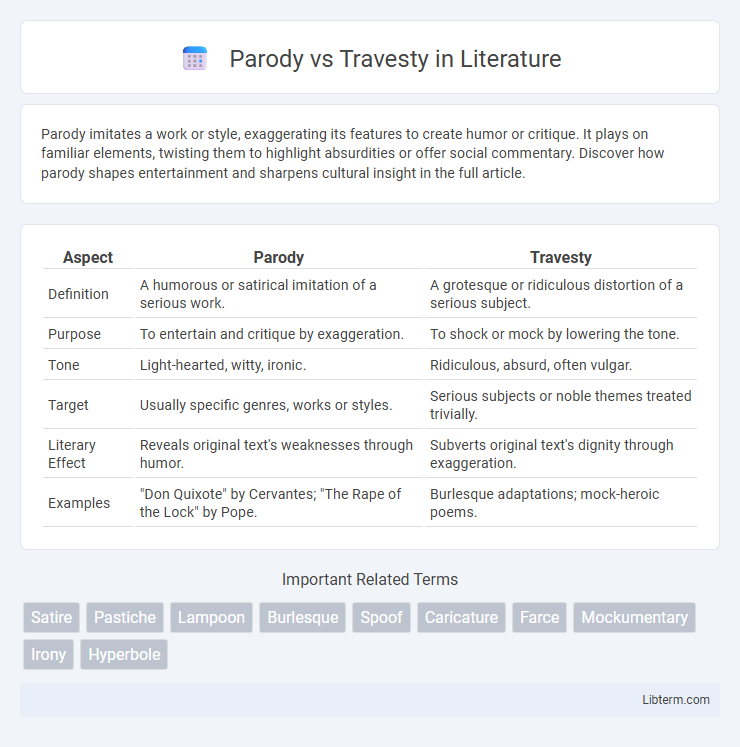Parody imitates a work or style, exaggerating its features to create humor or critique. It plays on familiar elements, twisting them to highlight absurdities or offer social commentary. Discover how parody shapes entertainment and sharpens cultural insight in the full article.
Table of Comparison
| Aspect | Parody | Travesty |
|---|---|---|
| Definition | A humorous or satirical imitation of a serious work. | A grotesque or ridiculous distortion of a serious subject. |
| Purpose | To entertain and critique by exaggeration. | To shock or mock by lowering the tone. |
| Tone | Light-hearted, witty, ironic. | Ridiculous, absurd, often vulgar. |
| Target | Usually specific genres, works or styles. | Serious subjects or noble themes treated trivially. |
| Literary Effect | Reveals original text's weaknesses through humor. | Subverts original text's dignity through exaggeration. |
| Examples | "Don Quixote" by Cervantes; "The Rape of the Lock" by Pope. | Burlesque adaptations; mock-heroic poems. |
Understanding Parody: Definition and Characteristics
Parody is a creative work that humorously imitates the style, tone, or content of an original piece to entertain or critique. It relies on exaggeration, irony, and recognizable features of the source material, making the imitation clear and engaging. Key characteristics include mimicry, satire, and a playful transformation that highlights the original's peculiarities while generating new meaning.
What is Travesty? Key Features Explained
Travesty is a form of literary or artistic imitation that exaggerates and distorts the original work to the point of absurdity, often stripping it of its serious tone to create humor or ridicule. Key features of travesty include the deliberate misrepresentation of characters, settings, or themes in an exaggerated and grotesque manner, emphasizing the ridiculous rather than subtle irony. Unlike parody, which maintains a recognizable connection to the source material for comedic effect, travesty transforms the original into something absurd and ludicrous, undermining its dignity completely.
Historical Origins of Parody and Travesty
Parody originated in ancient Greece, where playwrights mimicked epic poems to create humorous or satirical versions, serving both entertainment and critique. Travesty, emerging in the 18th century, adapted high art forms by presenting serious subjects in a grotesque or absurd manner, emphasizing ridicule rather than homage. Both genres evolved as artistic tools to challenge societal norms and literary conventions through exaggerated imitation.
Core Differences: Parody vs Travesty
Parody mimics and exaggerates the style or content of an original work, often with humor or satire, to highlight its distinctive features. Travesty, however, distorts a serious subject by treating it in a ridiculous or grotesque manner, reducing its dignity without direct imitation of style. The core difference lies in parody's affectionate critique through imitation, while travesty involves degrading a subject by inappropriate representation.
Common Purposes and Intentions in Parody
Parody and travesty both use humor and exaggeration to critique or entertain, but parody specifically aims to imitate and comment on the original work's style or content to provoke thought or laughter. The common purposes of parody include satirizing cultural norms, exposing flaws in the target subject, and providing social or political commentary through recognizable mimicry. Parody's intention often revolves around engaging audiences by balancing respect for the original with humorous subversion.
Travesty’s Role in Satire and Humor
Travesty employs exaggerated distortion to mock serious subjects, serving as a powerful tool in satire by highlighting absurdities through grotesque or ludicrous imitation. Unlike parody, which imitates style or content more directly, travesty reshapes the original tone into something absurd or ridiculous to provoke humor and critical reflection. This technique exposes folly and societal flaws by transforming revered or solemn texts into farcical representations, amplifying satirical impact.
Literary Examples of Parody
Parody in literature often involves humorous imitation of well-known works, such as "Don Quixote" by Miguel de Cervantes, which satirizes chivalric romances. Another famous example is "The Rape of the Lock" by Alexander Pope, mocking the trivialities of high society through epic poetry conventions. Travesty, by contrast, tends to distort serious subjects with grotesque or absurd treatment, lacking the affectionate tone found in parody.
Notable Instances of Travesty in Media
Notable instances of travesty in media often exaggerate or distort original works to the point of absurdity, such as Mel Brooks' film "Robin Hood: Men in Tights," which lampoons traditional Robin Hood narratives with extreme comedic distortion. Another example is the 1974 film "Blazing Saddles," which uses travesty to ridicule Western genre conventions through exaggerated characters and situations. These works highlight the use of travesty as a technique that undermines the seriousness of the subject for humorous or critical effect.
Cultural Impact: Parody vs Travesty
Parody and travesty both critique cultural norms by exaggerating familiar themes, but parody often highlights social or political issues through humor and satire, making it a powerful tool for cultural reflection and change. Travesty, characterized by absurd distortion and grotesque imitation, challenges cultural values by pushing boundaries of taste and decency, provoking audiences to reconsider societal taboos. Both forms influence cultural discourse, with parody fostering critical engagement and travesty disrupting traditional perspectives.
Choosing the Right Form: When to Use Parody or Travesty
Parody excels in satirical critique by humorously imitating the style of a specific work or genre, making it ideal for commentary on cultural or artistic subjects. Travesty distorts the original material with exaggerated absurdity to highlight its flaws or absurd elements, best suited for dramatic or serious content requiring a more extreme comedic approach. Choosing parody or travesty depends on whether subtle wit or overt ridicule better serves the intended message and audience engagement.
Parody Infographic

 libterm.com
libterm.com